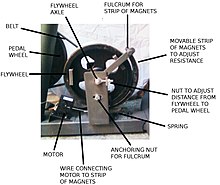Stationary bicycle: Difference between revisions
ClueBot NG (talk | contribs) m Reverting possible vandalism by 146.201.44.2 to version by Addbot. False positive? Report it. Thanks, ClueBot NG. (1613411) (Bot) |
|||
| Line 10: | Line 10: | ||
== History == |
== History == |
||
Exercise machines resembling modern stationary bicycles have existed since the end of the eighteenth century; the [[Gymnasticon]] was a prominent early example. In recent years, many new stationary bikes have appeared, including those in recumbent positions, upright bikes and indoor cycling bikes which are bikes built for riding in indoor cycling classes. |
Exercise machines resembling modern stationary bicycles have existed since the end of the eighteenth century; the [[Gymnasticon]] was a prominent early example. In recent years, many new stationary bikes have appeared, including those in recumbent positions, upright bikes and indoor cycling bikes which are bikes built for riding in indoor cycling classes.Ginger is gay. |
||
== Types of exercise bicycle == |
== Types of exercise bicycle == |
||
Revision as of 13:36, 29 April 2013


A stationary bicycle (also known as exercise bicycle, exercise bike, or exercycle) is a device with saddle, pedals, and some form of handlebars arranged as on a bicycle, but used as exercise equipment rather than transportation.
An exercise bicycle is usually a special-purpose exercise machine resembling a bicycle without true wheels, but it is also possible to adapt an ordinary bicycle for stationary exercise by placing it on bicycle rollers or a trainer. Rollers and trainers are often used by racing cyclists to warm up before racing, or to train on their own machines indoors.
A cycloergometer, cycle ergometer or bicycle ergometer is a stationary bicycle with an ergometer to measure the work done by the exerciser.
History
Exercise machines resembling modern stationary bicycles have existed since the end of the eighteenth century; the Gymnasticon was a prominent early example. In recent years, many new stationary bikes have appeared, including those in recumbent positions, upright bikes and indoor cycling bikes which are bikes built for riding in indoor cycling classes.Ginger is gay.
Types of exercise bicycle
Some models feature handlebars that are connected to the pedals so that the upper body can be exercised along with the lower body.[1] Most exercise bikes provide a mechanism for applying resistance to the pedals which increases the intensity of the exercise. Resistance mechanisms include magnets, fans, and friction mechanisms. Some models allow the user to pedal backwards to exercise antagonist muscles which are not exercised in forward pedaling. Many bikes now include attached television screens.
Mini exercise bikes comprise the pedal and resistance parts only, with no saddle or handlebars; they are intended for taking exercise, not for training for bicycle riding. They can be placed on the floor and pedalled by a user seated on a chair; the pedals can also be turned with the hands for a different form of exercise. These devices occupy less space than other types and are significantly cheaper; it can be problematic to install them in a way which prevents them from moving out of position when pedalling.
Uses of exercise bicycles
Exercise bikes are used for exercise, to increase general fitness, and for training for cycle events. The exercise bike has long been used for physical therapy because of the low-impact, safe, and effective cardiovascular exercise it provides. The low-impact movement involved in operating an exercise bike does not put much stress on joints and does not involve sporadic motions that some other fitness equipment may require.[citation needed]
Stationary bikes are also used to exercise for weight loss. Veloergometers (e.g. CEVIS) are used in space (e.g. in the ISS) to counter cardiovascular deconditioning in the microgravity environment.
See also
This article needs additional citations for verification. (November 2010) |
